Actin filaments at the leading edge of cancer cells are characterized by a high mobile fraction and turnover regulation by profilin I
- PMID: 24465723
- PMCID: PMC3895011
- DOI: 10.1371/journal.pone.0085817
Actin filaments at the leading edge of cancer cells are characterized by a high mobile fraction and turnover regulation by profilin I
Abstract
Cellular motility is the basis for cancer cell invasion and metastasis. In the case of breast cancer, the most common type of cancer among women, metastasis represents the most devastating stage of the disease. The central role of cellular motility in cancer development emphasizes the importance of understanding the specific mechanisms involved in this process. In this context, tumor development and metastasis would be the consequence of a loss or defect of the mechanisms that control cytoskeletal remodeling. Profilin I belongs to a family of small actin binding proteins that are thought to assist in actin filament elongation at the leading edge of migrating cells. Traditionally, Profilin I has been considered to be an essential control element for actin polymerization and cell migration. Expression of Profilin I is down-regulated in breast and various other cancer cells. In MDA-MB-231 cells, a breast cancer cell line, further inhibition of Profilin I expression promotes hypermotility and metastatic spread, a finding that contrasts with the proposed role of Profilin in enhancing polymerization. In this report, we have taken advantage of the fluorescence recovery after photobleaching (FRAP) of GFP-actin to quantify and compare actin dynamics at the leading edge level in both cancer and non-cancer cell models. Our results suggest that (i) a high level of actin dynamics (i.e., a large mobile fraction of actin filaments and a fast turnover) is a common characteristic of some cancer cells; (ii) actin polymerization shows a high degree of independence from the presence of extracellular growth factors; and (iii) our results also corroborate the role of Profilin I in regulating actin polymerization, as raising the intracellular levels of Profilin I decreased the mobile fraction ratio of actin filaments and slowed their polymerization rate; furthermore, increased Profilin levels also led to reduced individual cell velocity and directionality.
Conflict of interest statement
Figures
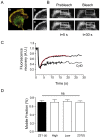
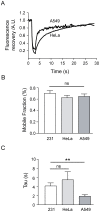

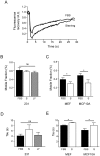
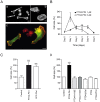

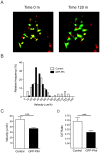
References
-
- Schafer DA, Cooper JA (1995) Control of actin assembly at filament ends. Annu Rev Cell Dev Biol 11: 497–518. - PubMed
-
- Pollard TD, Borisy GG (2003) Cellular motility driven by assembly and disassembly of actin filaments. Cell 112(4): 453–465. - PubMed
-
- Haugwitz M, Noegel AA, Karakesisoglou J, Schleicher M (1994) Dictyostelium amoebae that lack G-actin-sequestering profilins show defects in F-actin content, cytokinesis, and development. Cell 79: 303–314. - PubMed
-
- Verheyen EM, Cooley L (1994) Profilin mutations disrupt multiple actin-dependent processes during Drosophila development. Development 120: 717–728. - PubMed
Publication types
MeSH terms
Substances
LinkOut - more resources
Full Text Sources
Other Literature Sources
Miscellaneous

